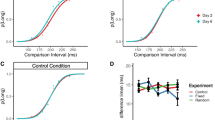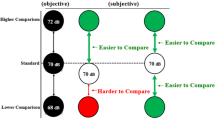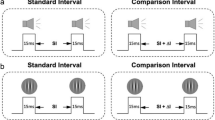Abstract
Sensory stimuli become easier to detect or distinguish with practice. It is generally assumed that the task-relevant stimulus dimension becomes increasingly more salient as a result of attentively performing the task at a level that is neither too easy nor too difficult. However, here we show improved auditory frequency discrimination following training with physically identical tones that were impossible to discriminate. We also show that learning transfers across tone frequencies and across modalities: training on a silent visuospatial computer game improved thresholds on the auditory discrimination task. We suggest that three processes are necessary for optimal perceptual learning: sensitization through exposure to the stimulus, modality- and dimension-specific attention, and general arousal.
This is a preview of subscription content, access via your institution
Access options
Subscribe to this journal
Receive 12 print issues and online access
$209.00 per year
only $17.42 per issue
Buy this article
- Purchase on Springer Link
- Instant access to full article PDF
Prices may be subject to local taxes which are calculated during checkout

Similar content being viewed by others
References
Demany, L. Perceptual learning in frequency discrimination. J. Acoust. Soc. Am. 78, 1118–1120 (1985).
Delhommeau, K., Micheyl, C., Jouvent, R. & Collet, L. Transfer of learning across durations and ears in auditory frequency discrimination. Percept. Psychophys. 64, 426–436 (2002).
Karmarkar, U.R. & Buonomano, D.V. Temporal specificity of perceptual learning in an auditory discrimination task. Learn. Mem. 10, 141–147 (2003).
Wright, B.A., Buonomano, D.V., Mahncke, H.W. & Merzenich, M.M. Learning and generalization of auditory temporal-interval discrimination in humans. J. Neurosci. 17, 3956–3963 (1997).
Wright, B.A. & Fitzgerald, M.B. Different patterns of human discrimination learning for two interaural cues to sound-source location. Proc. Natl. Acad. Sci. USA 98, 12307–12312 (2001).
Ahissar, M. & Hochstein, S. Learning pop-out detection: specificities to stimulus characteristics. Vision Res. 36, 3487–3500 (1996).
Fahle, M. Specificity of learning curvature, orientation, and vernier discriminations. Vision Res. 37, 1885–1895 (1997).
Herzog, M.H. & Fahle, M. The role of feedback in learning a vernier discrimination task. Vision Res. 37, 2133–2141 (1997).
Karni, A. & Sagi, D. The time course of learning a visual skill. Nature 365, 250–252 (1993).
Poggio, T., Fahle, M. & Edelman, S. Fast perceptual learning in visual hyperacuity. Science 256, 1018–1021 (1992).
Linkenhoker, B.A. & Knudsen, E.I. Incremental training increases the plasticity of the auditory space map in adult barn owls. Nature 419, 293–296 (2002).
Ahissar, M. & Hochstein, S. Task difficulty and the specificity of perceptual learning. Nature 387, 401–406 (1997).
Rubin, N., Nakayama, K. & Shapley, R. Abrupt learning and retinal size specificity in illusory-contour perception. Curr. Biol. 7, 461–467 (1997).
Trahiotis, C., Bernstein, L.R., Buell, T.N. & Spektor, Z. On the use of adaptive procedures in binaural experiments. J. Acoust. Soc. Am. 87, 1359–1361 (1990).
Tallal, P. et al. Language comprehension in language-learning impaired children improved with acoustically modified speech. Science 271, 81–84 (1996).
Moore, D.R., Rosenberg, J.F. & Coleman, J.S. Discrimination training of phonemic contrasts enhances phonological processing in mainstream school children. Brain Lang. 94, 72–85 (2005).
Amitay, S., Irwin, A., Hawkey, D.J.C., Cowan, J. & Moore, D.R. A comparison of adaptive procedures for rapid and reliable threshold assessment and training in naive listeners. J. Acoust. Soc. Am. 119, 1616–1625 (2006).
Amitay, S., Hawkey, D.J.C. & Moore, D.R. Auditory frequency discrimination learning is affected by stimulus variability. Percept. Psychophys. 67, 691–698 (2005).
Watanabe, T., Nanez, J.E. & Sasaki, Y. Perceptual learning without perception. Nature 413, 844–848 (2001).
Edeline, J.M. & Weinberger, N.M. Receptive field plasticity in the auditory cortex during frequency discrimination training: selective retuning independent of task difficulty. Behav. Neurosci. 107, 82–103 (1993).
Hawkey, D.J., Amitay, S. & Moore, D.R. Early and rapid perceptual learning. Nat. Neurosci. 7, 1055–1056 (2004).
Sussman, E., Winkler, I., Huotilainen, M., Ritter, W. & Näätänen, R. Top-down effects can modify the initially stimulus-driven auditory organization. Brain Res. Cogn. Brain Res. 13, 393–405 (2002).
Woldorff, M.G. et al. Modulation of early sensory processing in human auditory cortex during auditory selective attention. Proc. Natl. Acad. Sci. USA 90, 8722–8726 (1993).
Woldorff, M., Hillyard, S., Gallen, C.C., Hampson, S.R. & Bloom, F.E. Magnetoencephalographic recordings demonstrate attentional modulation of mismatch-related neural activity in human auditory cortex. Psychophysiology 35, 283–292 (1998).
Fritz, J., Shamma, S., Elhilali, M. & Klein, D. Rapid task-related plasticity of spectrotemporal receptive fields in primary auditory cortex. Nat. Neurosci. 6, 1216–1223 (2003).
British Society of Audiolo. Recommended procedures for pure-tone audiometry using a manually operated instrument. Br. J. Audiol. 15, 213–216 (1981).
Green, D.M. A maximum-likelihood method for estimating thresholds in a yes-no task. J. Acoust. Soc. Am. 93, 2096–2105 (1993).
Acknowledgements
We thank L. Halliday and E. Vavasour for collecting the additional data presented in Supplementary Figure 2, and S. Cirstea and M. Edmondson-Jones for assistance with statistical analysis. This study was entirely supported by the Medical Research Council, UK.
Author information
Authors and Affiliations
Contributions
S.A. and D.R.M. designed the study and prepared the manuscript, and all authors contributed to planning the experiments. A.I. collected most of the data. S.A. analyzed the data.
Corresponding author
Ethics declarations
Competing interests
D.R.M. declares that, as a director and shareholder in MindWeavers Ltd (see mindweaver.co.uk), there may be a perception of a conflict of interest with the results of this study. D.R.M. also declares, however, that the study was completed independently of MindWeavers and that the results were collected and analyzed by the other authors who have no involvement whatsoever in MindWeavers.
Supplementary information
Rights and permissions
About this article
Cite this article
Amitay, S., Irwin, A. & Moore, D. Discrimination learning induced by training with identical stimuli. Nat Neurosci 9, 1446–1448 (2006). https://doi.org/10.1038/nn1787
Received:
Accepted:
Published:
Issue Date:
DOI: https://doi.org/10.1038/nn1787
This article is cited by
-
Subliminal conditioning of vestibular perception generalizes within otolith organs
Journal of Neurology (2022)
-
Effect of “Spatially Separated Speech in Noise Training” on speech perception in noise in children with bimodal fitting
The Egyptian Journal of Otolaryngology (2021)
-
Short-term effects of sound localization training in virtual reality
Scientific Reports (2019)
-
A Randomized Controlled Crossover Study of the Impact of Online Music Training on Pitch and Timbre Perception in Cochlear Implant Users
Journal of the Association for Research in Otolaryngology (2019)
-
Learning to localise weakly-informative sound spectra with and without feedback
Scientific Reports (2018)



